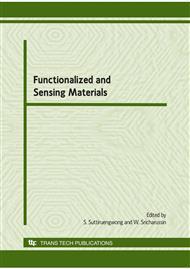p.672
p.675
p.679
p.683
p.687
p.691
p.695
p.699
p.703
Effect of pH on Zinc Oxide Powder Prepared by a Chemical Co-Precipitation Method
Abstract:
Zinc oxide powder was prepared by a chemical co-precipitation method. Zinc nitrate and ammonium hydroxide were used as the starting precursors. The white precipitated powder was formed after adding ammonium hydroxide until the pH of final solution was 7-9. The powder was filtered and dried at 100 °C for 24h. The phase of zinc oxide powder was studied by X-ray diffractometer (XRD). Hexagonal single phase of zinc oxide was obtained without calcination step. The morphology of zinc oxide powder was investigated by scanning electron microscope (SEM). The particle was irregular in shape and highly agglomerated with an average particle size of 0.1 µm. The chemical composition of zinc oxide powder was determined by energy dispersive X-ray spectrometer (EDXS). The elemental composition of zinc oxide showed the characteristic X-ray energy value as follows: zinc of Lα = 1.012 keV, Kα = 8.630 keV and Kβ = 9.570 keV and oxygen of Kα = 0.525 keV, respectively.
Info:
Periodical:
Pages:
691-694
Citation:
Online since:
January 2010
Price:
Сopyright:
© 2010 Trans Tech Publications Ltd. All Rights Reserved
Share:
Citation:


